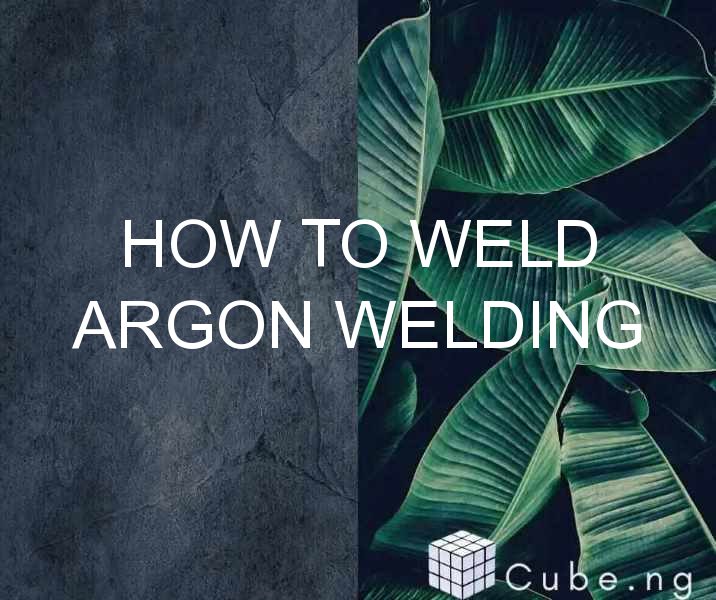Table of Contents
How to Weld Using Argon Welding
Welding is an essential process in the metal fabrication industry, and it involves fusing metals together by applying heat and pressure. The welding process requires a welding machine, a welding electrode or filler material, and a shielding gas. Argon welding is a type of welding that uses argon gas as a shielding gas to protect the weld from atmospheric contamination. In this article, we will discuss how to weld using argon welding.
What is Argon Welding?
Argon welding, also known as gas tungsten arc welding (GTAW), is a welding process that uses a non-consumable tungsten electrode to produce the weld. The process involves creating an arc between the tungsten electrode and the workpiece, and the heat generated by the arc melts the metals together. Argon gas is used as the shielding gas to protect the weld from atmospheric contamination. Argon welding is commonly used for welding aluminum, stainless steel, and other non-ferrous metals.
Equipment Required for Argon Welding
To perform argon welding, you will need the following equipment:
- Welding machine: A welding machine capable of producing direct current (DC) is required for argon welding. The welding machine should be capable of producing a high-frequency start to initiate the arc.
- Tungsten electrode: A non-consumable tungsten electrode is used in argon welding. The size of the tungsten electrode depends on the thickness of the metal being welded.
- Filler material: A filler material is used to fill the gap between the metal being welded. The filler material should be compatible with the metal being welded.
- Argon gas: Argon gas is used as the shielding gas in argon welding. The purity of the argon gas should be at least 99.99%.
Setting Up the Welding Machine
Before starting the argon welding process, you need to set up the welding machine. Follow these steps to set up the welding machine:
- Connect the ground clamp to the workpiece.
- Connect the torch to the welding machine's positive terminal.
- Connect the gas hose to the shielding gas inlet on the welding machine.
- Turn on the welding machine and set the welding current to the appropriate level for the metal being welded.
- Adjust the gas flow rate to the appropriate level. The gas flow rate should be between 10 and 20 cubic feet per hour (CFH).
Preparing the Tungsten Electrode
The tungsten electrode should be prepared before starting the welding process. Follow these steps to prepare the tungsten electrode:
- Grind the tungsten electrode to a point using a grinding wheel. The point should be sharp and have a diameter that matches the thickness of the metal being welded.
- Clean the tungsten electrode using a clean, lint-free cloth.
Starting the Arc
To start the arc, follow these steps:
- Place the torch close to the workpiece.
- Press the foot pedal to initiate the high-frequency start.
- Once the arc is initiated, lift the torch to the desired height.
- Move the torch slowly along the joint, keeping the tungsten electrode pointed in the direction of the weld.
Welding Technique
When welding with argon, it is important to maintain a consistent arc length and travel speed. Follow these tips to achieve a good weld:
- Maintain a consistent arc length of between 1/16 and 1/8 inches.
- Move the torch slowly along the joint, maintaining a travel speed of 1 to 2 inches per second.
- Use a weaving motion to ensure even penetration of the weld.
- Use the correct filler material and ensure that it is melted into the base metal.
Safety Precautions
Welding can be hazardous, and it is important to take appropriate safety precautions. Follow these safety precautions when performing argon welding:
- Wear appropriate personal protective equipment, including a welding helmet, gloves, and protective clothing.
- Ensure that the work area is well-ventilated to prevent the inhalation of toxic fumes.
- Keep flammable materials away from the welding area.
- Do not touch the welding electrode or the workpiece while the welding machine is in operation.
Conclusion
Argon welding is a versatile welding process that can be used to weld a variety of metals. By following the steps outlined in this article, you can learn how to perform argon welding and achieve high-quality welds. Remember to take appropriate safety precautions when performing welding to avoid injury.
FAQs
-
What is the advantage of using argon gas in welding?
Using argon gas as a shielding gas in welding provides better protection against atmospheric contamination, resulting in a high-quality weld. -
Can I use argon welding to weld ferrous metals?
Argon welding is not recommended for welding ferrous metals because it does not provide sufficient penetration for these types of metals. -
How thick of a metal can I weld using argon welding?
Argon welding can be used to weld metals of varying thicknesses. The size of the tungsten electrode and the welding current should be adjusted to suit the thickness of the metal being welded. -
Can I use a different type of gas instead of argon gas?
Other types of gases can be used as shielding gases in welding, but argon gas is the most commonly used gas for argon welding. -
How long does it take to learn how to weld using argon welding?
The length of time it takes to learn how to weld using argon welding depends on the individual's skill level and experience. However, with practice and proper training, it is possible to become proficient in argon welding in a relatively short amount of time.




